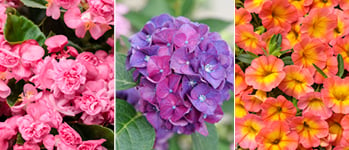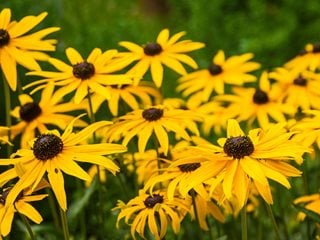Growing Glorious Black-Eyed Susans
With daisy-like blooms that last for weeks, these prolific wildflowers bring nonstop color to the late-summer gardenRight on cue during the dog days of August, black-eyed Susans (Rudbeckia) illuminate flower gardens and open fields everywhere like bright rays of sunshine. If any plant could be the poster child of late summer it would be this one. The brightly colored flowers in cheery shades of lemon-yellow, orange, and gold bloom for weeks with minimal care. They also attract a continuous procession of pollinators, bringing even more color and vibrancy to the summer garden.
In the past few years, an impressive array of garden cultivars in a complete gamut of heights, colors, and forms has been developed. These new-generation Susies offer greater flair and versatility, making them suitable for settings ranging from prairie-style plots to urban gardens.
On this page: Basics | How To Plant | Growing Tips | Popular Varieties | Good Companions
On this page:
- BASICS
- HOW TO PLANT BLACK-EYED SUSAN
- BLACK-EYED SUSAN GROWING TIPS
- BLACK-EYED SUSAN VARIETIES
- COMPANIONS
BLACK-EYED SUSAN BASICS
Rudbekia is a member of the sunflower family (Asteraceae) and has similar daisy-like flowers. Although black-eyed Susans are also called coneflowers because of their cone-shaped heads, they should not be confused with purple coneflowers (Echinacea purpurea). Both flowers come from the same plant family and require similar growing conditions, but the color and appearance of the flowers differ. Confusion also arises when gardeners come across the black-eyed Susan vine (Thunbergia alata). This unrelated Rudbeckia look-alike is a tender, warm-climate perennial native to Africa.
Zones:
Varies by species, but the typical range is 3 through 9.
Exposure:
Full sun (See more full-sun perennials).
Bloom period:
Plants have a long bloom period even without deadheading, typically flourishing from late July until the first frost. Some cultivars, such as ‘Early Bird Gold’, have extended bloom times and will begin flowering in mid to late spring.
Height:
Varies dramatically, anywhere from 10 inches to 7 feet, depending on the cultivar.
Flower characteristics:
Flower sizes range from 2 to 9 inches wide and can be single, semi-double, or fully double. The petals range in shade from bright yellow to orange-gold, and some cultivars display flushes of red, bronze, or mahogany. The flower's eye, or center, is actually more dark brown than black, but some cultivars, such as ‘Prairie Sun’, have green centers.
Common types:
There are about 25 species of Rudbeckia, all native to North America. Many species are actually biennials or short-lived perennials but because they self-sow readily, they often return each spring from seed dispersed the previous fall. Rudbeckia hirta (common black-eyed Susan) and R. fulgida (orange coneflower) are the species most readily available to gardeners and include many of the newest cultivars. However, there are number of other species worth seeking out because of their unique attributes including R. maxima (large coneflower), R. laciniata (tall coneflower), R. triloba (brown-eyed Susan or three-lobed coneflower), R. subtomentosa (sweet coneflower), and R. nitida (shiny coneflower).
HOW TO PLANT BLACK-EYED SUSAN
When to plant:
Plant black-eyed Susan plants in the spring after the last frost, or 6 weeks before the first frost in fall.
Where to plant:
Rudbeckia will thrive in just about any sunny location that has well-drained soil. They will tolerate drought better than they will soggy ground. If you live in a hot, humid climate, choose a spot in the garden where your plants will receive ample air circulation to avoid the development of powdery mildew.
Growing from seed:
Seeds can be started indoors about 10 weeks before your last frost date, following package directions for depth. Be sure to harden seedlings off before planting them outside. (Read more on how to start seeds indoor.)
Seeds can also be planted directly in the garden. Scatter seeds over the soil, then gently press them in or cover with a very light layer of soil. Water regularly to keep the seedbed moist. As seedlings grow, thin to 6 to 12 inches apart for dwarf varieties and annuals and 18 to 30 inches apart for perennials, depending on the mature size of the plant. Water thoroughly to keep the soil moist until your plants become established. Once they are well-rooted, they will be able to tolerate dry conditions.
GROWING TIPS
Like most wildflowers, black-eyed Susans are remarkably carefree, drought-tolerant, and disease resistant. Even so, here are some steps you can take to prolong their bloom time and keep them healthy:
- To extend the flowering period, deadhead your plants by pinching off the blooms at the base of the stem. You can cut also cut back black-eyed Susans after they flower to encourage a second surge of blooms later in the fall.
- If you want to attract birds to your garden, leave a few flower heads on your plants and let them to go to seed. You’ll also be rewarded by new seedlings sprouting up in the garden the following spring.
- Because Rudbeckia are zealous self-seeders, you may end up with more plants than you bargained for. If your plot becomes overcrowded, remove or transplant the extras.
- You can propagate perennial black-eyed Susans by division in early spring, just as growth begins to develop, or in the fall after they finish flowering. Simply dig up the root ball and cut it with a sharp knife, making sure each division has roots. Replant the divisions about 12 to 18 inches apart.
- Black-eyed Susans don’t like water lingering on their foliage, which can result in powdery mildew. Be sure to maintain adequate spacing between plants and water at soil level rather than watering from above.
POPULAR VARIETIES
GOOD COMPANIONS
Although the bright, sunny flowers and dark center cones of black-eyed Susans create a striking color contrast on their own, these versatile plants pair beautifully in the garden with other summer- and fall-blooming perennials and annuals. Try some of these high-impact looks:
- Combine them with the cool blues and purples of Russian sage (Perovskia atriplicifolia), fall-blooming asters, tall verbena (Verbena bonariensis), salvia, and giant hyssop (Agastache 'Blue Fortune').
- Heat things up by grouping them with other warm-colored bloomers such as yarrow (Achillea ‘Terracotta’), zinnias, and tiger lily (Lilium lancifolium).
- If you go gaga for daisies, plant a cutting garden of daisies and their look-alikes, filling it with black-eyed Susans, purple coneflowers (Echinacea purpurea), shasta daisies (Leucanthemum xsuperbum), and sunflowers (Helianthus).
- Attract a diversity of butterflies and bees by intermingling black-eyed Susans with other pollinator-friendly perennials of various colors, heights, and textures. Good choices include Sedum ‘Autumn Charm’, showy goldenrod (Solidago speciosa), Joe Pye weed (Eutrochium purpureum), bee balm (Monarda), blazing star (Liatris spicata), and butterfly weed (Asclepias tuberosa).
- Because Rudbeckia are native plants, they are a natural addition to prairie-style gardens and harmonize well with large drifts of ornamental grasses, such as switchgrass (Panicum virgatum), maiden grass (Miscanthus sinensis), little bluestem (Andropogon scoparius), and fountain grass (Pennisetum alopecuroides).
RELATED:
20 Drought-Tolerant Plants
20 Flowers for Your Summer Garden
The Best Perennials for Pollinators
20 Fabulous Fall Flowers
21 Low-Maintenance Plants

















